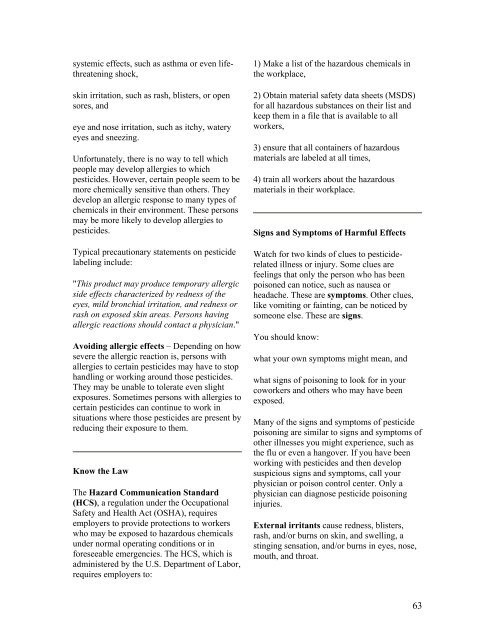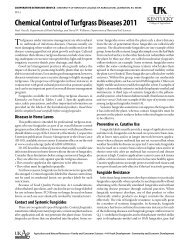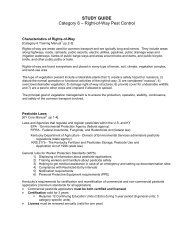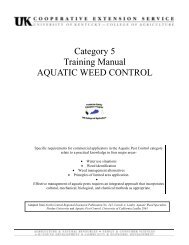Applying Pesticides Correctly - University of Kentucky
Applying Pesticides Correctly - University of Kentucky
Applying Pesticides Correctly - University of Kentucky
Create successful ePaper yourself
Turn your PDF publications into a flip-book with our unique Google optimized e-Paper software.
systemic effects, such as asthma or even lifethreatening<br />
shock,<br />
skin irritation, such as rash, blisters, or open<br />
sores, and<br />
eye and nose irritation, such as itchy, watery<br />
eyes and sneezing.<br />
Unfortunately, there is no way to tell which<br />
people may develop allergies to which<br />
pesticides. However, certain people seem to be<br />
more chemically sensitive than others. They<br />
develop an allergic response to many types <strong>of</strong><br />
chemicals in their environment. These persons<br />
may be more likely to develop allergies to<br />
pesticides.<br />
Typical precautionary statements on pesticide<br />
labeling include:<br />
"This product may produce temporary allergic<br />
side effects characterized by redness <strong>of</strong> the<br />
eyes, mild bronchial irritation, and redness or<br />
rash on exposed skin areas. Persons having<br />
allergic reactions should contact a physician."<br />
Avoiding allergic effects – Depending on how<br />
severe the allergic reaction is, persons with<br />
allergies to certain pesticides may have to stop<br />
handling or working around those pesticides.<br />
They may be unable to tolerate even slight<br />
exposures. Sometimes persons with allergies to<br />
certain pesticides can continue to work in<br />
situations where those pesticides are present by<br />
reducing their exposure to them.<br />
Know the Law<br />
The Hazard Communication Standard<br />
(HCS), a regulation under the Occupational<br />
Safety and Health Act (OSHA), requires<br />
employers to provide protections to workers<br />
who may be exposed to hazardous chemicals<br />
under normal operating conditions or in<br />
foreseeable emergencies. The HCS, which is<br />
administered by the U.S. Department <strong>of</strong> Labor,<br />
requires employers to:<br />
1) Make a list <strong>of</strong> the hazardous chemicals in<br />
the workplace,<br />
2) Obtain material safety data sheets (MSDS)<br />
for all hazardous substances on their list and<br />
keep them in a file that is available to all<br />
workers,<br />
3) ensure that all containers <strong>of</strong> hazardous<br />
materials are labeled at all times,<br />
4) train all workers about the hazardous<br />
materials in their workplace.<br />
Signs and Symptoms <strong>of</strong> Harmful Effects<br />
Watch for two kinds <strong>of</strong> clues to pesticiderelated<br />
illness or injury. Some clues are<br />
feelings that only the person who has been<br />
poisoned can notice, such as nausea or<br />
headache. These are symptoms. Other clues,<br />
like vomiting or fainting, can be noticed by<br />
someone else. These are signs.<br />
You should know:<br />
what your own symptoms might mean, and<br />
what signs <strong>of</strong> poisoning to look for in your<br />
coworkers and others who may have been<br />
exposed.<br />
Many <strong>of</strong> the signs and symptoms <strong>of</strong> pesticide<br />
poisoning are similar to signs and symptoms <strong>of</strong><br />
other illnesses you might experience, such as<br />
the flu or even a hangover. If you have been<br />
working with pesticides and then develop<br />
suspicious signs and symptoms, call your<br />
physician or poison control center. Only a<br />
physician can diagnose pesticide poisoning<br />
injuries.<br />
External irritants cause redness, blisters,<br />
rash, and/or burns on skin, and swelling, a<br />
stinging sensation, and/or burns in eyes, nose,<br />
mouth, and throat.<br />
63







